I recently had an interesting conversation with my former colleague Mike Kalen, CEO of Covr Financial Technologies. Mike is a frequent speaker on InsurTech and FinTech innovation and he is an advisor to several early stage companies and has extensive experience as a leader in the insurance and financial services industry.
Your background is interesting Mike — you came from the insurance side, and now the focus is venture capital investing and InsurTech. Can you tell us about your work history?
“I’m currently very active in how venture capital and private equity capital is investing in innovating and changing the landscape of the financial services and insurance industries. There’s so many exciting things being brought to the market – new business models, new technology and dynamic leadership. This trend will definitely continue to shape our future in a positive way.

I started my career at Prudential Financial as a financial analyst and quickly realized that the real business was working with clients and ran one of Prudential’s insurance agencies. It was in this role that I learned what our industry really does for our clients. After 2 years of working with clients and helping our financial advisors grow their practices, I helped lead the transformation of Prudential’s insurance agent channels by helping build Prudential’s first RIA, building our fee-based planning business, expending life insurance and annuity product choices and leading the insurance and the estate planning division of Prudential Securities where we were helping financial advisors bring protection solutions to their clients. Prudential was a great experience and provided a foundation of serving clients and growing organizations.
From there, I became the President of the life insurance company of The Hartford for four years. We were the largest distributor of VUL, UL, and term insurance, through financial institutions. Our customers were banks, broker dealers, wirehouses, and independent agents. We had the largest point-of-sale field force to help financial advisors position insurance solutions. We experienced rapid growth as financial institutions committed to offering clients protection solutions. I then became CEO of Hartford Europe. We sold variable annuities through independent financial advisors in the UK and Germany. We created a new market. We were a new player and created a new brand and product space for that market, ultimately growing our sales to new $2B in new annuity premium per year.
After 7 years at The Hartford, I become an executive advisor with Aquiline Captial Partners, one of the largest private equity firms focused exclusively on insurance and financial services. During that time, Aquiline built a portfolio of diverse companies focused on all aspects of insurance, financial services and insurance related technologies. We took particular interest in the rapidly growing fixed annuity business and created the business plan for Futurity First and ultimately their CEO. Through organic growth and acquisitions, we became one of the largest distributors of fixed indexes annuities through independent agents in the United States. I am now the CEO of a venture capital backed insurtech company called Covr Financial Technologies.”
That’s a great background. What does Covr do and how is it helping shape the future of insurance and financial services?
“Covr has built a platform of tools to support financial advisors, banks and other firms looking to simplify the life insurance process for their advisors and clients. We make the process more efficient by taking steps in the process and make it easier to make life insurance part of a full financial plan.
Technology is rapidly changing how protection products are brought to market. Digital innovation, predictive analytics, new underwriting methodologies, etc are making products easier to understand and more competitive for customers. Advisors and financial institutions are capitalizing on this innovation.”
I’d love to hear more about your perspective on digital innovation. Where do you think it’s taking us in 2019, and beyond?
“The first tangible trend we see for 2019 is sales force enablement. Technology is helping advisors provide smarter solutions and more innovation is going to happen. These products are complicated, and what we find is consumers need advice to understand the different benefits, features, and how it fits into their overall plan. There are really interesting things going on in life and annuity, relative to sales enablement. Making the process more interactive and the products simpler to understand, with the help of an advisor. The second trend we are focused on is on-demand insurance. There’s evidence that a percentage of the market can and will buy directly without an advisor. Technology helps guide the process and advice is delivered via new means. The third trend is relative to product underwriting. Access to customer financial and health data through third party sources helps improve the quality and timeliness of underwriting and lets companies offer more competitive products with less time and cost. Finally, there’s also a lot of other things behind the scenes, that most customers and advisors don’t see, with predictive analytics and call center efficiency that are improving the customer experience.
The two things we’re most focused on is sales force enablement and how direct to consumer channels will emerge in 2019. The macro trends favor protection solutions tied to a financial plan and buying from trusted channels.”
Knowing there’s going to be disruption and change in the industry, what do you think the carrier landscape will look like in the future? What happens to the companies that can’t keep up over the next three to five years?
“Almost all carriers I’m aware of are adapting – some faster than others. The progressive firms do two things very well relative to innovation. First, they all have venture capital arms. Some examples are Mass Mutual, Allianz, MetLife, AXA, NY Life and USAA Ventures. If you look at who they’ve invested in, they’re fuelling a lot of the innovation and taking an investment position in this technology wave. Even if their main company is still focused on traditional distribution, they’re diversifying things through general account investments. Second, they’ve integrated innovation, not siloed innovation. Five years ago, the innovation officer was stuck in a corner in a lab. Today, they’re out of the lab and partnering with the head of sales or the head of product or the head of underwriting, and they’re much more integrated in the business. It is encouraging that innovation is more closely connected to the business owners.”
If you were a producer, how would you change your practice today to take advantage of what’s coming?
“You really have to look at every phase of your practice and embrace technology. How can an advisor work collaboratively with a client during the sales process? Smart advisors are bringing the internet or a digital solution into the discussion early on. You’re showing them connectivity, you’re showing how the product works and how they can track it online. So I think the salesperson of the future absolutely needs to be in that collaborative, engaged environment from the very beginning. Saying,“I can send you a link to track your policy” or “you’ll get your statements in the mail”, won’t work in today’s environment.”
How does Covr help someone do that?
“Covr’s built a advisor-based insurance platform that guides them and their clients through the process. Our needs analysis tool for life insurance, disability income and long term care is customized to client needs, not an out of the box solution. We use simple drivers that allow the client to customize their insurance solution. Also, all of our products have a comparison tool. We’ve built a have a digitally-oriented tool that shows clients the cost, benefits and features on a comparative basis. We can run a multi-dimensional comparison of the different products that are in the market to help the client understand the difference between Product A and Product B. It helps the client get comfortable that the advisor has done shopping for the client and is bringing them the most appropriate solution rather than just sending them an illustration and selling to that. If advisors are talking to their clients about holistic solutions for retirement planning and protection, our solutions are also embedded with the Money Guide Pro financial planning tool.
Through the application process offer the client choice of completing the application online or with the help of their advisor and our call center. We have a dedicated team asks the underwriting questions in a secure and safe environment, and therefore customers are more comfortable talking to a trusted call center than talking to their advisor about their medical history. All the way through the process we are trying to deploy technology to aid the process. If the advisor can embrace that, we can modernize the experience.
Finally, as the industry innovates products, we are extremely well positioned to bring these new solutions to proven distribution channels. We see the direct to consumer market for protection growing slowly, we see the advisor and trusted channel outlets growing rapidly.”
I’m excited to watch the success of Covr as it continues to grow. One final question. It’s Saturday morning, you have no responsibilities whatsoever. Describe for me your perfect morning.
“I’m probably doing something with my family. We love the outdoors and we’ll either take a walk on a Saturday morning around the reservoir or take a drive to one of the great spots in New England to ski, fish, golf or hike.”

